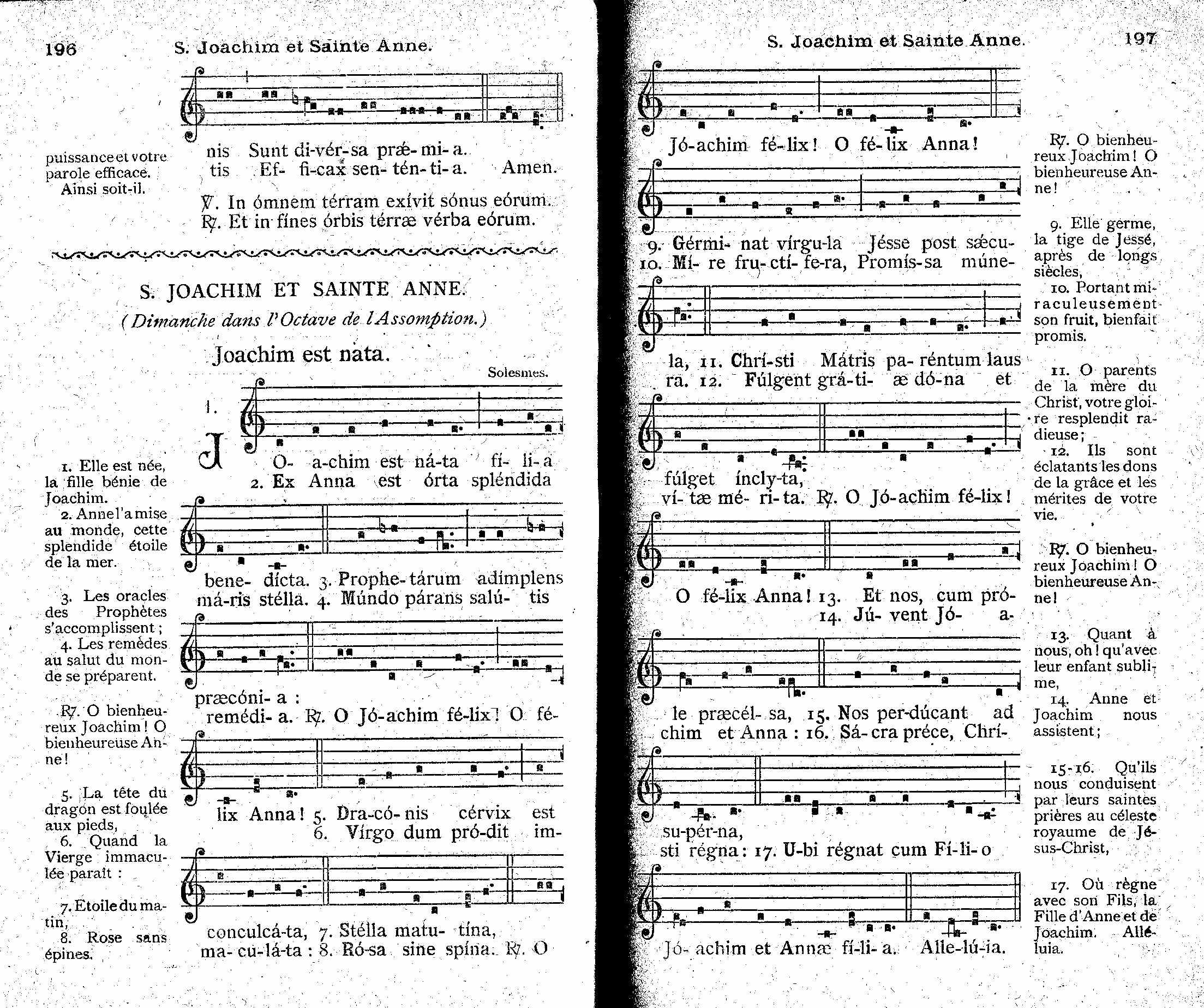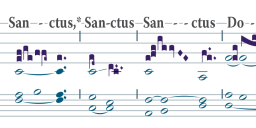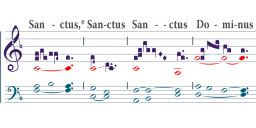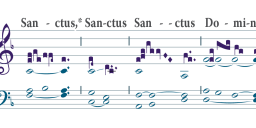Koerber's Hybrid Chant Notation and the NOH
-
OK peoples. I think I am closer to perfecting my hybrid notation. Here it demonstrates how to maintain the latin chant and set a modern accompaniment for organ using the NOH. Let me know what you think.
See The DemonstrationThanked by 1lmassery -
Quite beautiful! Is this your Lenten discipline? Lots of very careful work, to be sure!
-
Bravo!
-
I'm still not a fan of this, but it's definately a step in the right direction from the last version.
-
Daniel
No, I am just intent on making our beautiful chant accessible to all. This is the template. Perhaps I should hold it to myself to do the entire Mass for Lent though. With illuminations. -
I don't like it for monophony, but this is a brilliant usage of it! I don't like reading the NOH due to the lack of neums, but this gets the best of both worlds! I want to see more of this!
-
Matthew
It makes a lot more sense to use the hybrid for organ accompaniment.
However, my amateur musicians in the choir and who cantor value the modern staff so they know what notes to plunk out on the piano. I turn Aristotles psalms into hybrid each week. -
What about colors? I think distinguishing the chant in an alternate color is good but what colors? Colors from Manuscripts from earlier times? Suggestion?
-
I really like the NOH accomps. Who were the composers?
-
I think my organist would love it. And my occasional schola would really start to see how the neums relate to the notation that they are familiar with. Thank you, Francis!
Oh- and I like the color differentiation as well. Black and purple, maybe? -
Hi Jenny
You are quite welcome. I am looking for ways to promote our venerable chant in every way possible. I am fortunate to be able to test these methods here at OLM where I am the DoM.
I have found in general that my colleagues do not care for the hybrid and understandably so. But this is not about the pros. We prefer the authentic chant notation. But then one must know all of their scales and key signatures if one is to play it out on an instrument. Sight singing chant is a breeze, but try playing it in any key on any instrument by reading GN and I would wager only a handful of my colleagues can even do that.
The hybrid is about bridging the gap to our everyday musicians (and less experienced pros) in the parish. And for keeping the chant in tact along with adding accomps or polyphony. -
I almost hate to say it, but I would find this helpful if I were accompanying chant (which I do not normally do). Otherwise, I basically have to have the chant memorized (which is not necessarily a bad thing). Perhaps having the Laon or St. Gall neumes written above the accompaniment would be even better, but how crazy would that look!
-
All is possible. Do you prefer to use those systems instead of the Gregorian?
-
Ideally, I would have all the chants as memorized as I have the short Communion Visionem quam. In the meantime, it is hard for me to look at the NOH without wondering what the square notes look like, and hard to read from square notes without wondering what the staffless neumes look like.
-
I've been playing weekly from the NOH. And I always compare it to the Graduale for rhythmic adjustments. They did have a system - a method to their madness. I can pretty much tell what the square notation is from the physical groupings of the round notes in the NOH. Anything out of the ordinary (probably a pun, if I worked it a bit) takes a bit of getting used to.
-
I bet that's probably true. I spent some time reading out of a Vatican edition graduale today, and I could probably tell you where all the dots, ictuses, and episemata would have been in the Solesmes edition without looking at one.
-
The Grenoble edition used conventional chant notation on a five-line staff with a G clef. Specimens appear in Alec Robertson's book, THE INTERPRETATION OF PLAINCHANT (OUP, 1937).
-
N.B. old thread...
Have been meaning to post on this Hybrid Chant notation for sometime. A whole book...

 Joachimestnata.jpg2207 x 1848 - 611KThanked by 1francis
Joachimestnata.jpg2207 x 1848 - 611KThanked by 1francis -
Link to sample was broken. Fixed now.
-
I LOVE THIS!!! What software are you using to work these wonders?
-
Alec Robertson in The Interpretation of Plainchant (1937) reproduced specimens from what he called the "Grenoble Edition" of the Graduale Romanum, that employed this system of notation (conventional chant notation on a five-line staff with G clef). I have never been able to locate a copy of this "Grenoble editions."
-
On some level this appeals to me because it is EASIER to sit down at a piano or organ and play the melody and thus learn the chant without having excellent sight-singing skills.
But I also know that if ALL THE CHANT was available like this, I would rely on it too much. Everything would be pitched the way the books indicate, I would never develop better sight-singing skills, and tuning would suffer from the imposition of equal-temperament on the learning process.
I see the benefit for organ accompaniment editions. But for vocal editions it seems like one more way in which church music shoots itself in the foot by attempting to provide shortcuts.Thanked by 1francis -
I see the benefit for organ accompaniment editions. But for vocal editions it seems like one more way in which church music shoots itself in the foot by attempting to provide shortcuts.
I agree. And if you want to pitch it around, you could run into issues with key signatures, which is one of the biggest advantages of using neumes anyways.
For vocal scores, let's keep neumes as neumes and mn as mn.Thanked by 1francis -
yea, this is simply if you want to accompany the chant from the organ. nothing else.
-
Adam, I agree on your pedagogical point. As far as moving the pitch, just use the capo. Fixed!
-
JSHerman:
Most of what I do is accomplished using InDesign. Everything is a vector object. This calls for a very large amount of artistic sense since it guides you to do nothing in terms of layout, placement, size, etc. of notes. It really is a hand engraving method using the computer as the papyrus.Thanked by 1JSHerman -
Some programmer type with a knowledge of music should somehow integrate gregorio and lilypond to create these scores automatically... hmmm... Adam? Adam?Thanked by 1ryand
-
One thing I noticed in the first example is that there was not enough white space between staves. Here is another example.

 Picture 2.png1240 x 422 - 58K
Picture 2.png1240 x 422 - 58K -
hmmm... ledger lines are little skimpy. new version.

 Picture 3.png1245 x 428 - 58K
Picture 3.png1245 x 428 - 58K -
I find your writing-over the top line of the staff makes it hard to read the notes. The Cs look like Es.Thanked by 1Ben
-
It appears important that the round notes line up precisely with the neumes up above them. Which makes the first note in the fourth phrase confusing - you moved it over a smidge so it doesn't overlap. But this approach could get you into big trouble in other situations. And how do you handle the time synchronization on a podatus, salicus, porrectus etc. where there's no horizontal separation?
It almost makes me wonder if it would be worth the trouble to mark the exact neum you're syncing with - like in a different color or something. I'd be tempted to use a vertical episema, except ... that's taken.
Have you tried having two five-line staves under a four-line? Does it end up being impossible to read? I wouldn't think it would be any harder than 3, 4 or even 5 5-line staves stacked on top of each other. -
Carl:
That is an excellent idea-just put the chant staff above a grand staff. -
just put the chant staff above a grand staff.
like this?
 20141230160149_00001.jpg2550 x 3300 - 1M
20141230160149_00001.jpg2550 x 3300 - 1M -
yet another version via Carls suggestions.

 Picture 5.png1301 x 558 - 61K
Picture 5.png1301 x 558 - 61K -
Of course, the main reason for this treatment as opposed to having two staves with duplicate (and possibly competing information) is so the organist and the schola are in absolute sync, which is a bit more difficult if the organist is reading modern notation and is not aware of the subtleties of chant notation. I found this to be the case in the NOH. I believe the NOH assumes that the organist has intimate knowledge of the subtleties in the chant, and is using modern notation as a simple guide. This can create issues for organist not familiar with the subtleties, hence why I developed this concept to begin with.
-
Salieri: (and supporters [thankers])
That is an example utilizing simple neumes, (as does the 1940), but not compound neumes, where subtlety is QUITE important for nuance. And if we are to be excellent, NUANCE cannot be ignored. Therefore, as Carl mentions, it is quite difficult to know when a note occurs or does not occur in a "podatus, salicus, porrectus etc." hence, Hybrid Notation is necessary, if not indispensable (for the organist).
[apodictic statement] We don't follow a metronome when singing GC. Don't rely on MN for GC as it is an inferior way to read (sing) GC. [/apodictic statement]
And for the members of the schola who are intellectually alert, it is also excellent to know what the organist will be doing, so including the GC in the same grand staff makes it much easier to have that intimate non-verbal communication between schola and accompanist. (Good artists will understand what I am speaking about here.)
Lastly, this takes up less real estate on the printed page. Win-win.
P.S. I forgot to mention one very important thing. This is in Latin (universal). Your example is in English (vernacular, culturally exclusive). -
OK, I'll expose my lack of organ knowledge here - my piano education stopped about 45 years ago. In the second phrase, there's a line extending from middle C to the following re. Does this indicate that the organist is to play the re and do, even though they're in square notes?
I also notice that you have do marked as C. But that will only work when it's a convenient singing range, so I wonder what happens when this is transposed. And why is this marked in the key of F (B flat at the beginning of the line) when it's in the key of C? It works for this particular selection, but I can imagine other situations where the complexity of mapping the 5-line modern clef to the 4-line ancient stave could get out of hand.
But I'd have to spend a lot of time trying to do this myself with a lot of different chants, and my accompaniment skills are ... nonexistent. -
Carl:
Thanks for your input and questions. Yes, the horizontal line means the chant notes are simply switchig voices at that point.
All of your other questions are simple. This is an exact duplicate of the NOH accompaniment which you might not be familiar with.
Here is the NOH in pdf.
 nohSanctus.pdf64K
nohSanctus.pdf64K
Welcome to the MusicaSacra Forum!
To participate in the discussions on Catholic church music, sign in or register as a forum member, The forum is a project of the Church Music Association of America.
Categories
- All Discussions21,096
- General Music Discussion8,211
- Job Openings197
- Management of Music Programs850
- Choral Matters532
- Church Documents and Rubrics524
- CMAA Notes301
- Events716
- For Newcomers: Read First26
- Sacred Polyphony546
- Hymnody872
- Gregorian Chant: General2,697
- ↳ Graduale Romanum and Liber Usualis368
- ↳ Graduale Simplex60
- ↳ Semiology63
- Vernacular Plainsong696
- Anglican Use and Anglican Chant68
- Organ, Other Instruments and Repertoire435
- New Composition/Works in Progress1,290
- Recordings230
- Music for Hispanic Ministry159
- Music Education: Children211
- Music Education: General222
- News Items245
- Positions Wanted2
- General Discussion: Catholicism739
- Amusements177
- General Discussion1,033
- Opinions117












